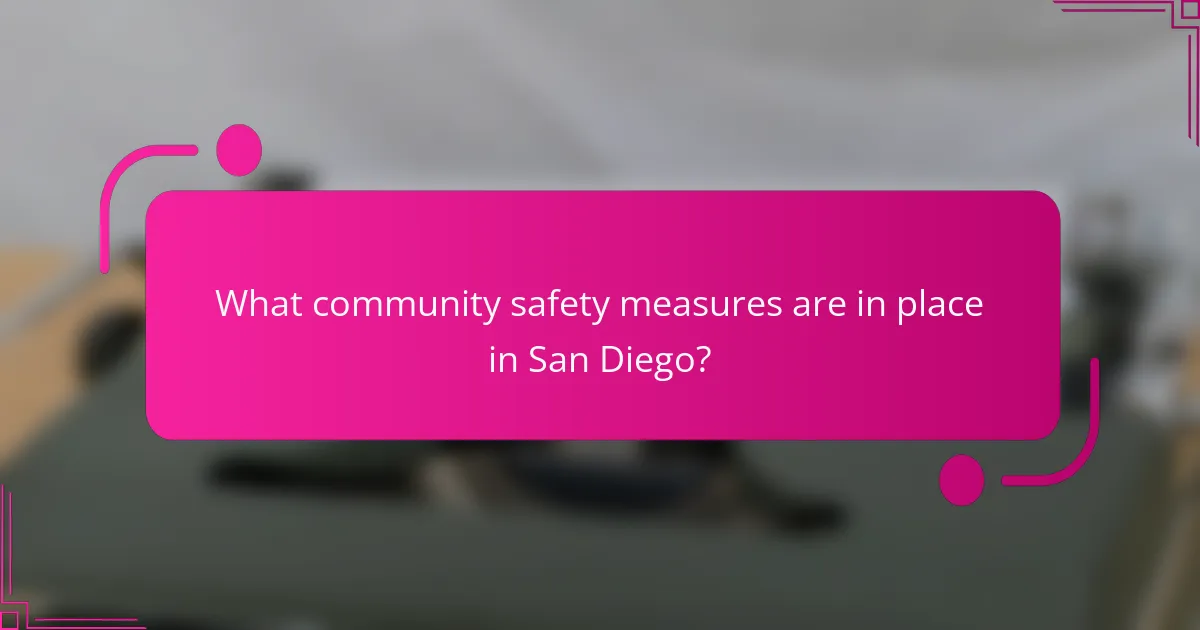
What are the current crime rates in San Diego?
As of 2023, San Diego’s overall crime rate has shown a slight decrease compared to previous years. The city reported approximately 4,000 violent crimes in the past year. This statistic reflects a rate of about 4.5 incidents per 1,000 residents. Property crimes, including burglary and theft, totaled around 25,000 incidents. This results in a property crime rate of roughly 28.5 per 1,000 residents. These figures indicate ongoing efforts in community safety and crime prevention strategies. Data is sourced from the San Diego Police Department’s annual crime report.
How do San Diego crime rates compare to national averages?
San Diego crime rates are generally lower than national averages. According to the FBI’s Uniform Crime Reporting Program, in 2021, the violent crime rate in San Diego was approximately 3.4 incidents per 1,000 residents. This is below the national average of 6.9 incidents per 1,000 residents. Property crime rates in San Diego also show a similar trend, with a rate of about 25.6 incidents per 1,000 residents, compared to the national average of 22.0 incidents per 1,000 residents. While property crime is slightly higher in San Diego, the overall crime rates indicate a safer environment relative to many other U.S. cities.
What types of crimes are most prevalent in San Diego?
Property crimes are the most prevalent types of crimes in San Diego. This category includes burglary, theft, and motor vehicle theft. According to the San Diego Police Department’s annual report, property crimes accounted for over 60% of all reported crimes in the city. Violent crimes, such as assault and robbery, are less common but still significant. In recent years, the city has seen a rise in drug-related offenses. These trends indicate ongoing challenges in community safety, prompting local initiatives for crime prevention.
How have crime rates changed over the past decade?
Crime rates in San Diego have generally declined over the past decade. According to the San Diego Police Department, overall crime decreased by 8% from 2011 to 2021. Violent crimes, such as homicides and aggravated assaults, saw a notable decrease during this period. Property crimes, including burglary and theft, also experienced a downward trend. In 2020, the city reported a 12% drop in property crimes compared to the previous year. However, some categories like motor vehicle theft saw fluctuations, with a slight increase in certain years. Data from the FBI’s Uniform Crime Reporting Program supports these trends, indicating a broader national decline in crime rates.
What factors influence crime rates in San Diego?
Factors influencing crime rates in San Diego include socioeconomic status, policing strategies, and community engagement. Areas with higher poverty levels often experience increased crime rates. Effective policing can deter criminal activity. Community programs that promote safety and engagement can reduce crime. Additionally, local demographics and housing conditions play significant roles. Historical crime data shows fluctuations based on these factors. For instance, improved community outreach has correlated with a decline in certain crime types.
How does socioeconomic status affect crime rates?
Socioeconomic status significantly affects crime rates. Areas with lower socioeconomic status often experience higher crime rates. This correlation is primarily due to factors such as poverty, unemployment, and lack of education. Studies show that individuals in lower-income neighborhoods may resort to crime out of economic necessity. For example, the Bureau of Justice Statistics indicates that communities with high poverty rates report increased incidents of violent crime. Additionally, limited access to social services can exacerbate criminal behavior. Research by the National Institute of Justice supports the link between socioeconomic disparities and crime prevalence.
What role does population density play in crime trends?
Population density significantly influences crime trends. Higher population density often correlates with increased crime rates. Urban areas with dense populations tend to experience more property crimes and violent offenses. According to the FBI’s Uniform Crime Reporting Program, cities with higher density report greater incidents of crime per capita. This trend can be attributed to factors such as anonymity, social disorganization, and economic disparities. In contrast, areas with lower population density typically report lower crime rates. Studies show that rural regions often have stronger social ties, which can deter criminal behavior. Thus, population density plays a crucial role in shaping crime dynamics in urban environments.

What community safety measures are in place in San Diego?
San Diego has implemented various community safety measures to enhance public security. The San Diego Police Department conducts regular patrols and community outreach programs. Neighborhood watch programs encourage residents to report suspicious activities. The city employs surveillance cameras in high-crime areas to deter criminal behavior. Additionally, the San Diego Community Oriented Policing (COP) program fosters collaboration between police and community members. Emergency response systems are in place for quick action during incidents. The city also offers crime prevention workshops to educate residents on safety practices. These measures collectively aim to reduce crime and improve community safety.
How effective are local law enforcement strategies?
Local law enforcement strategies are generally effective in reducing crime rates. Research shows that community policing initiatives lead to a significant decrease in violent crimes. A study by the National Institute of Justice found that areas with proactive policing saw a 20% reduction in crime over five years. Additionally, data from the San Diego Police Department indicates that crime rates dropped by 10% following the implementation of targeted enforcement strategies. These strategies often involve collaboration with community organizations, which enhances trust and cooperation between residents and law enforcement. Overall, local law enforcement strategies play a crucial role in improving community safety and reducing crime.
What community policing initiatives are currently active?
Currently active community policing initiatives include the San Diego Police Department’s Neighborhood Policing Program. This program focuses on building relationships between officers and community members. Officers engage in regular community meetings to discuss safety concerns. They also participate in local events to foster trust and collaboration. Another initiative is the Community Engagement Division, which promotes outreach and education. This division works to address specific neighborhood issues through partnerships. The SDPD also utilizes the Community Oriented Policing Services (COPS) model. This model emphasizes problem-solving and proactive measures to reduce crime. These initiatives aim to enhance community safety and improve quality of life.
How does community engagement impact crime reduction?
Community engagement significantly impacts crime reduction by fostering trust and cooperation between residents and law enforcement. Engaged communities are more likely to report suspicious activities, leading to quicker police responses. Studies indicate that neighborhoods with active community programs experience lower crime rates. For instance, a report from the National Institute of Justice found that community policing initiatives reduced crime by up to 30% in certain areas. Additionally, community involvement in crime prevention strategies enhances social cohesion. This social cohesion discourages criminal behavior and promotes a sense of ownership over neighborhood safety. Overall, community engagement acts as a vital mechanism for crime reduction.
What resources are available for residents to enhance safety?
Residents can enhance safety through various community resources. Local law enforcement agencies offer crime prevention programs and neighborhood watch initiatives. Community centers provide workshops on safety awareness and emergency preparedness. Online platforms, such as Nextdoor, facilitate communication about local safety concerns. The San Diego Police Department also hosts public safety events to educate residents. Additionally, the city provides access to safety apps that report incidents and connect with emergency services. These resources collectively empower residents to take proactive measures in enhancing their safety.
What neighborhood watch programs exist in San Diego?
San Diego has several neighborhood watch programs aimed at enhancing community safety. The San Diego Police Department supports these programs through its Neighborhood Watch program. This initiative encourages residents to work together to monitor their neighborhoods.
Additionally, the Community Engagement Division of the San Diego Police offers resources and training for neighborhood watch groups. These programs focus on crime prevention and building community relations.
Many neighborhoods have established their own watch groups, tailored to local needs. The city also provides online resources to help residents start their own neighborhood watch. These efforts have been shown to reduce crime rates in participating areas.
How can residents access crime statistics for their area?
Residents can access crime statistics for their area through local law enforcement websites. Most police departments publish annual crime reports online. These reports include data on various types of crimes. Additionally, residents can use online crime mapping tools. Websites like NeighborhoodScout and CrimeReports provide interactive maps. These platforms allow users to view crime data based on specific locations. Local government websites may also offer crime statistics. Many municipalities maintain databases for public access. These resources help residents stay informed about safety in their communities.

What prevention strategies are being implemented in San Diego?
San Diego is implementing various prevention strategies to enhance community safety. These strategies include community policing initiatives, which foster collaboration between law enforcement and residents. Additionally, the city is utilizing data-driven approaches to identify crime hotspots. Programs aimed at youth engagement, such as after-school activities, are also in place to deter juvenile delinquency. San Diego has invested in mental health resources to address underlying issues contributing to crime. Furthermore, neighborhood watch programs empower residents to take an active role in crime prevention. The city also focuses on improving lighting in public areas to enhance safety. These combined efforts aim to reduce crime rates and promote a safer community.
How do educational programs contribute to crime prevention?
Educational programs contribute to crime prevention by equipping individuals with knowledge and skills that deter criminal behavior. These programs often focus on life skills, conflict resolution, and decision-making. They aim to reduce risk factors associated with crime, such as lack of education and employment opportunities. Research indicates that youth who participate in educational programs are less likely to engage in criminal activities. For instance, a study by the National Institute of Justice found that educational initiatives can reduce juvenile crime rates by up to 30%. Additionally, community-based education fosters social cohesion, which is linked to lower crime rates. Overall, educational programs serve as a proactive approach to crime prevention by addressing underlying issues that contribute to criminal behavior.
What types of youth outreach initiatives are in place?
Youth outreach initiatives include mentorship programs, educational workshops, and community service projects. Mentorship programs connect at-risk youth with positive role models. Educational workshops cover topics like conflict resolution and job readiness. Community service projects engage youth in local improvement efforts. These initiatives aim to reduce crime by fostering positive relationships and skills. Research shows that mentorship can decrease delinquency rates by 30%. Programs like “San Diego Youth Services” provide structured support and resources. Overall, these initiatives are vital for promoting safety and community engagement.
How do schools collaborate with law enforcement?
Schools collaborate with law enforcement through various structured programs and initiatives. These partnerships often include the presence of School Resource Officers (SROs) on campuses. SROs serve as a bridge between students and law enforcement, promoting safety and trust. Additionally, schools conduct joint training exercises with police to prepare for emergencies. They also share information about potential threats or criminal activity in the area. Regular meetings between school officials and law enforcement help address safety concerns. Collaborative efforts are aimed at creating a safe educational environment. According to the National Association of School Resource Officers, effective collaboration can reduce crime and enhance student safety.
What role does technology play in crime prevention?
Technology plays a crucial role in crime prevention by enhancing surveillance and data analysis. Advanced surveillance systems, such as CCTV cameras, deter criminal activity through monitoring. Real-time data analytics help law enforcement identify crime hotspots and allocate resources effectively. Predictive policing tools analyze historical crime data to forecast potential incidents. Community engagement platforms enable citizens to report suspicious activities easily. Additionally, mobile applications facilitate communication between police and the community. These technological advancements contribute to a safer environment by increasing responsiveness and accountability in law enforcement.
How are surveillance systems utilized in San Diego?
Surveillance systems in San Diego are utilized primarily for crime prevention and public safety. These systems include CCTV cameras placed in high-crime areas. They help law enforcement monitor activities in real-time. The footage from these cameras aids in investigations and evidence collection. Additionally, surveillance systems deter criminal behavior by increasing the perceived risk of apprehension. Community partnerships enhance the effectiveness of these systems. Local organizations often collaborate with police to share surveillance footage. This collaborative approach has been shown to reduce crime rates in monitored areas. Overall, surveillance systems play a crucial role in enhancing community safety in San Diego.
What apps or platforms help residents report crime?
Several apps and platforms assist residents in reporting crime. Notable examples include Nextdoor, Citizen, and local police department apps. Nextdoor allows users to share neighborhood concerns and report incidents. Citizen provides real-time alerts about nearby crimes and allows users to report incidents directly. Many police departments have dedicated apps for residents to report crimes and submit tips. These platforms enhance community engagement and safety. They facilitate quicker responses from law enforcement.
What can residents do to improve their personal safety?
Residents can improve their personal safety by staying aware of their surroundings. This means being vigilant in public spaces and avoiding distractions like mobile phones. They should also establish a safety plan, which includes identifying safe routes and emergency contacts. Engaging with local community watch programs enhances neighborhood safety through collective vigilance. Additionally, residents can secure their homes with proper locks and lighting to deter intruders. According to the FBI, neighborhoods with active watch programs experience a 20% reduction in crime rates. Regularly attending community safety meetings can provide valuable information and resources.
What safety tips should residents follow in their daily lives?
Residents should follow several safety tips in their daily lives. Always lock doors and windows when leaving home. Use deadbolts for added security. Be aware of your surroundings when walking or driving. Avoid distractions such as mobile phones in public spaces. Keep emergency numbers easily accessible. Report suspicious activities to local authorities promptly. Participate in community watch programs to enhance neighborhood safety. Regularly update personal safety plans to adapt to changing environments.
How can residents stay informed about local crime trends?
Residents can stay informed about local crime trends by utilizing various resources. They can subscribe to local police department newsletters. These newsletters often provide updates on crime statistics and safety tips. Residents can also follow community forums and social media groups focused on local safety. Many neighborhoods have dedicated platforms for discussing crime issues. Attending community meetings can provide direct insights from law enforcement. Additionally, local news outlets frequently report on crime trends. Websites like CrimeReports or SpotCrime offer real-time data on local incidents. Engaging with these resources helps residents stay aware of safety issues in their area.
San Diego is the primary entity discussed in this article, focusing on its crime rates, community safety measures, and prevention strategies. As of 2023, the city has seen a slight decrease in overall crime rates, with approximately 4,000 violent crimes and 25,000 property crimes reported. The article compares San Diego’s crime statistics to national averages, highlights prevalent crime types, and examines factors influencing crime rates, such as socioeconomic status and population density. Additionally, it outlines community safety initiatives, law enforcement strategies, and the role of technology in crime prevention, providing residents with resources to enhance their safety and stay informed about local crime trends.